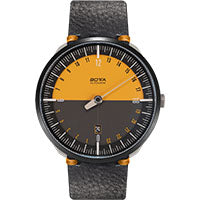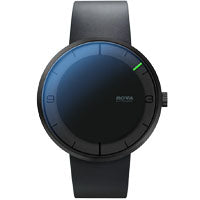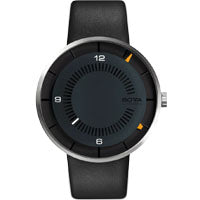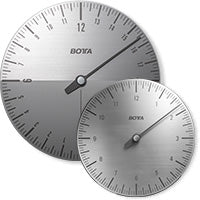From the celestial bodies to the mechanical one-handed clock to the atomic clock
Time as well as the wandering phases of the celestial bodies sun and moon have fascinated mankind from the very beginning. Already several ancient cultures recognized independently of each other that time can be measured by sunrise and sunset as well as the wandering movement of the shadows. The history of timepieces begins with the perception and recording of the natural course of time. From the Egyptians' sundial and water clock, through the mechanical one-hand watch and pocket watch, to the atomic clock - the history of the clock spans at least 5000 years.
Sundials and the natural course of time
Early forms of a calendar probably already had hunters and gatherers in the last ice age. However, our present watch has its origins in the Sumerians and ancient Egyptians, who are considered the inventors of time measuring devices. Even the sundials based on shadow bars around 3000 BC had decisive features of our watches today: The sundials were usually designed in a circular shape to symbolize the course of the sun and divided day and night into twelve units each.
However, the simple principle of the sundial had its drawbacks: it did not capture the different lengths of day and night time in summer or winter, nor did it work at night or on sunless days. Accordingly, people's lives at that time were mainly based on the light-dark rhythm.Water clock: Time display for day and night time
In 1520 B.C., Amenemhet, the keeper of the victories under the Egyptian king Amenophis I, took on both problems of the sundial: The water clock, designed for his king, not only enabled him to read the time at night, but also took into account the different number of night hours in summer and winter time. The water clock was not based on the observation of the celestial bodies and defined units of time by flowing water from one container into another.
The principle was finally also the basis for the hourglass, which spread from the 14th century onwards. Another measuring instrument that made the time display independent of day and night was, for example, the candle clock from 900 AD.Time measurement for the general public – the mechanical one-handed clock
Since time measuring devices were rarely found in private households, in the Middle Ages bell towers were used to acoustically indicate important times of the day and night such as prayer times or opening times of the city gates to the citizens.
The first mechanical clocks, called wheel clocks, were the next step to make timekeeping accessible to the general public. They mark the beginning of the watchmaker's craft and the development towards today's clock. Initially distributed in the form of table clocks only in monasteries to indicate prayers or used by the tower keeper to strike the bells at the correct time, the wheel clock finally entered the public domain as a tower clock.It is not known when the first mechanical clock was developed, but the first clocks are recorded around 1300. The first mechanical clocks were designed as one-handed clocks (clock with one hand, no minute hand), but were far inferior in accuracy to the sundials, which had meanwhile matured. It was not until the 17th century that the technology had advanced to such an extent that it made sense that an additional minute hand would from then on divide the time into even smaller units.
The invention of the pocket watch: From common property to omnipresence
The pocket watch finally made time measurement accessible to a broader section of the population and decoupled it from fixed locations.
The manufacture of the small watch was made possible by the development of the mainspring, which stored energy for the movement and thus detached the watch from its place of installation. At the beginning of the 16th century, the Nuremberg master locksmith Peter Henlein was one of the first to combine the spring with a rate regulator, thus reducing the watch to pocket size. The "Nuremberg Egg Watch" is one of the first representatives of the pocket watch. For a long time, Henlein was considered the inventor of the pocket watch in egg shape, but ultimately the authorship cannot be proven.The wristwatch had its origins in small watches that were specially designed for women and could be worn on the arm. Only the pilot's watch made the wristwatch attractive for men. Against the pocket watch, however, the wristwatch could only prevail in the First World War. Inventions such as the waterproof watch from Rolex, which achieved fame when Mercedes Gleitze crossed the English Channel on October 7, 1927, and the automatic watch invented by John Harwood in 1923, further supported this development.
Whereas until then the fascination of watches had been primarily with machines and less with exact timekeeping, the luxury object developed into an everyday object through constant mechanization and an increasingly industrialized manufacturing process. The increasing ownership of watches led to an omnipresence of time that continues to this day. At the same time, the demand for the accuracy of the time display increased.
The quest for precision: more and more precession
Inventions such as the spring drive, the balance wheel and the pendulum as rate regulators, and the discovery of isochronism have made mechanical clocks increasingly precise over time, and last but not least, the introduction of the first world time, Greenwich Mean Time, has led to a uniform determination of time. Even more precise than the mechanical watch, however, proved to be the quartz watch invented as early as 1921 and largely replaced the wheel clock in the second half of the 20th century.
The atomic clock, first introduced in 1949 and used today primarily in science and space travel, is the most accurate clock to date. Radio-controlled watches, whose time displays are synchronized with atomic clocks by radio signal, have been passing on their precession to the general public since the 1960s.With the increasing perception of time, clocks for determining time differences such as the stopwatch or stamp clock were also invented in the 19th century. The mechanical alarm clock also became increasingly important during industrialization and was patented by Antoine Redier in 1847.
Opposing trends: One-handed watch versus multifunctional Smartwatch
Two opposing trends can currently be observed in the watch sector: On the one hand, there is the development towards more and more function and information on the wrist. The keyword here is Smartwatch (or Applewatch). These are electronic digital devices that can do much more than just display the time.
The range of functions of such devices is more like that of a smartphone than that of a classic watch. The idea behind it sounds very promising: the wearer should be able to capture all kinds of data in a very small space, record it and possibly even send it. There is a relatively close and almost seamless interaction between the wearer and Smartwatch. However, this also requires a rather intensive and permanent occupation of the wearer with his electronic "helper".The "user" has to deal very intensively with the sometimes highly complex product "Smartwatch". He has to recharge it regularly, synchronize it, maintain it, update it - and last but not least evaluate and manage the data obtained.
This is exactly where the second current trend comes in - the counter-trend. Born from the desire to reduce complexity.
On the other hand, there is a growing number of people who consciously oppose overloading their lives with technology and its possibilities and consider a reduction to the essentials to be the more attractive way.This user group often very consciously decides against multifunctionality and the "burden of many possibilities". Instead, they appreciate the quality of simplification. A watch as a time indicator - and - not unimportant: as a symbol of a sovereign state of mind and corresponding value thinking.
Probably the most consistent form of this reduction to the essentials is found in the UNO wristwatch. This one-hand watch, which was created and developed by physicist and designer Klaus Botta in 1986, aims to achieve precisely this simplification - in an environment of constant complication. Particularly in the automatic version, it combines intelligent reduction, high design standards and highly developed watchmaking art "Made in Germany" to create a modern classic with a philosophical background on the philosophy of time.











3 comments
Guten Abend Klaus! (hoffe, ich darf dich duzen)
Erstmal danke für deinen sehr informativen Beitrag zum Thema Uhren.
Ich gehöre wohl zu jenen, die mit “smart” etc. nichts anfangen können, bzw. in meinem Fall nicht wollen.
Ich habe mich daher, wie vielleicht viele andere, zurückbesonnen, auf die Uhrmacherkunst im eigentlichen Sinne. Okay, “Glashütte”, “OMEGA” oder ähnliches kommt für mich nicht in Frage.
Ich bin geborener “OSSI” und habe mich daher für die Uhrenwerke in Ruhla (Thüringen) interessiert. Zu DDR-Zeiten eine “Hochburg” der Uhrenproduktion!.
Na jedenfalls bin ich bei einem der Nachfolgemanufakturen und zwar der “UMF Ruhla” fündig geworden.
Seit einiger Zeit bin ich nun stolzer Besitzer einer auf 500 Stück limitierten “UMF Ruhla – Melkus”- Edition (mit schweizer Ronda Quarzwerk 5020.B). Obwohl ich eigentlich auf der Suche nach einer mechanischen Uhr war, hat mich hier die Optik der Uhr und ihr geschichtlicher Bezug zur Familie “Melkus” absolut berührt. Meine weitere UMF Ruhla ist eine von lediglich 200 Stück in Ruhla hergestellten Handaufzugsuhren.mit dem vormals russischen Werk “Poljot 3133”. Nähere Infos zum Uhrwerk gibt es gewiss bei “UMF Ruhla” oder eben im www.
Die Uhr besticht allein durch ihre Optik. Das teilweise vergoldete mechanische Uhrwerk sowie die faszinierende Chronometer-Mechanik lassen sich durch das rückseitige Saphirglas wunderschön beobachten.
Ich kann jeden verstehen, der sich auf das “Ursprüngliche” unseres Daseins besinnt. Für mich gehören mechanische Uhren zum “Weltkulturerbe”!
Mit lieben Grüßen an alle Uhren – Fetischisten
Frank aus Barleben (bei Magdeburg)
Hallo liebes Botta Team,
Ihre Philosophie die hinter ihren Uhren steht finde ich sehr gut.
Reduzierung auf das Wesentliche,verpackt in einem tollem Design, sowie das durchdachte Konzept.
Viele Grüße
Detlef Koprinc
Hallo liebes Botta Team,
Ihre Philosophie die hinter ihren Uhren steht finde ich sehr gut.
Reduzierung auf das Wesentliche,verpackt in einem tollem Design, sowie das durchdachte Konzept.
Viele Grüße
Detlef Koprinc